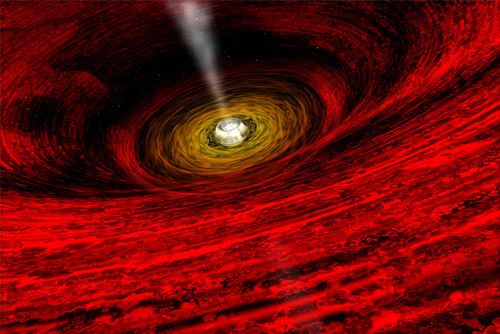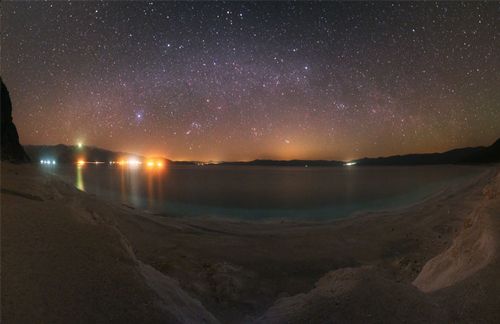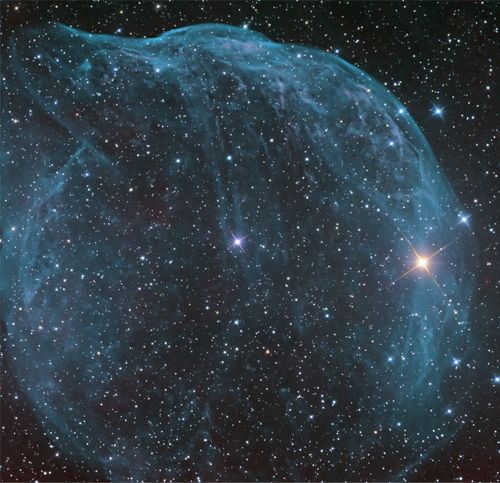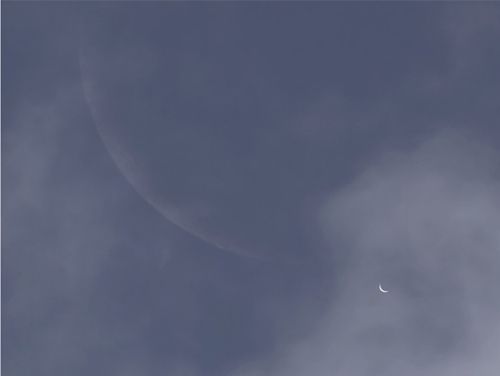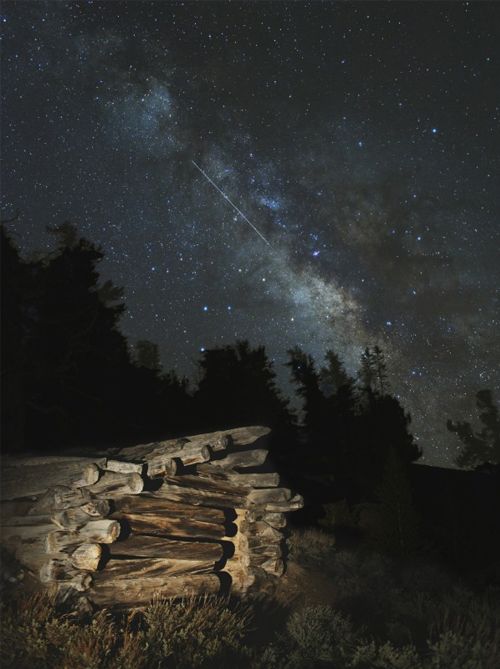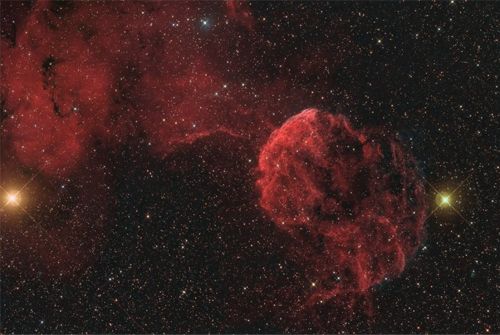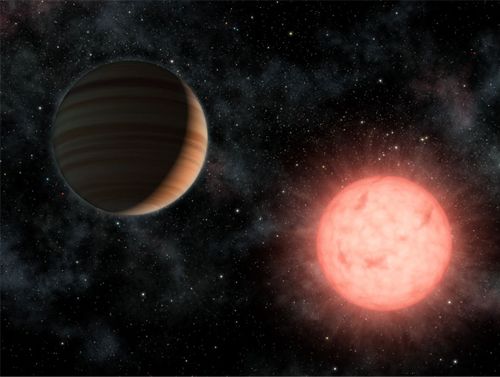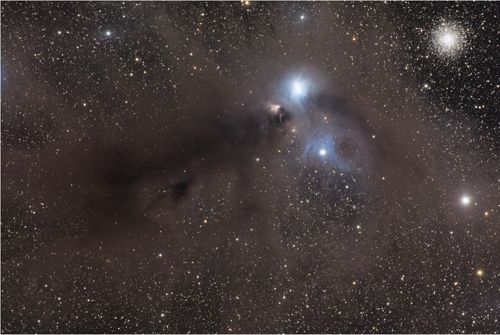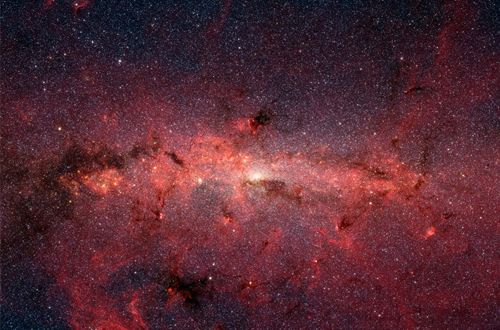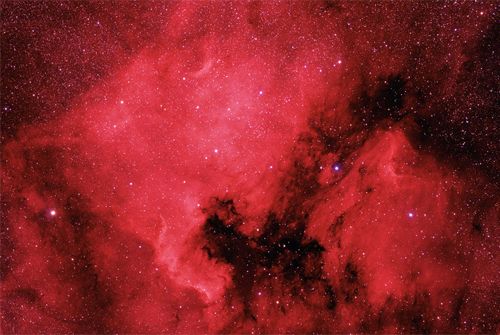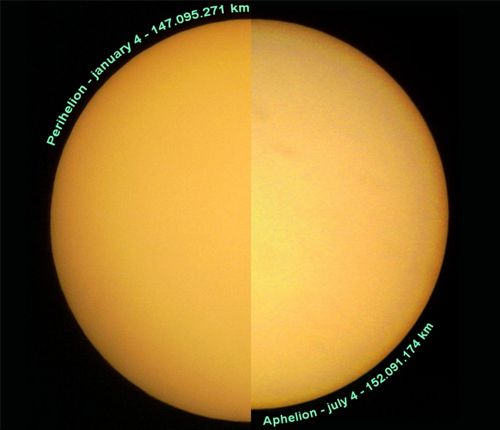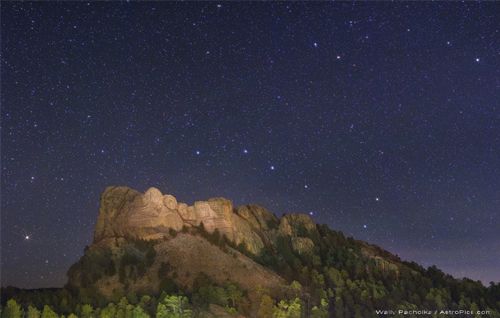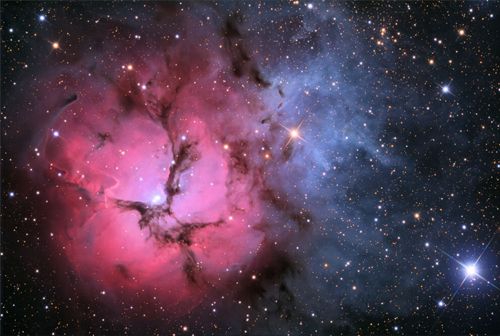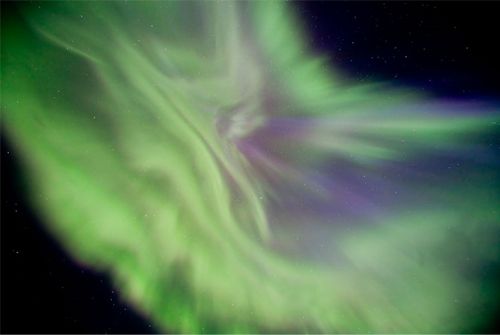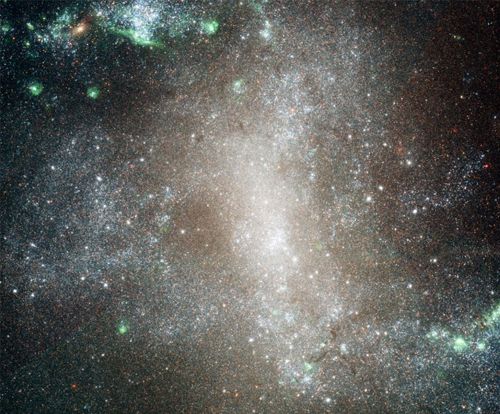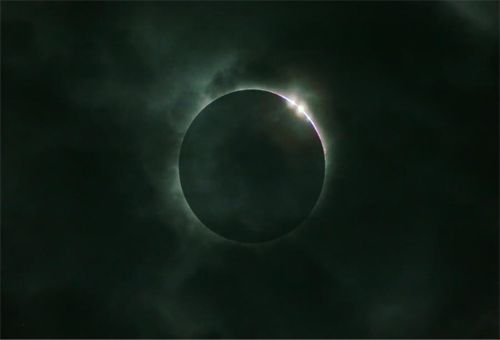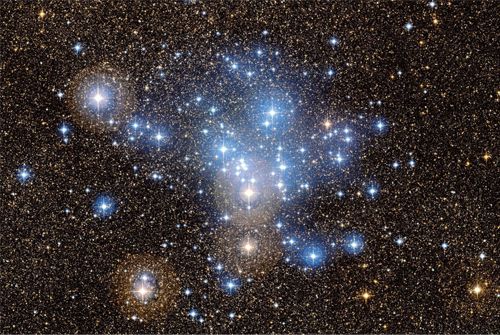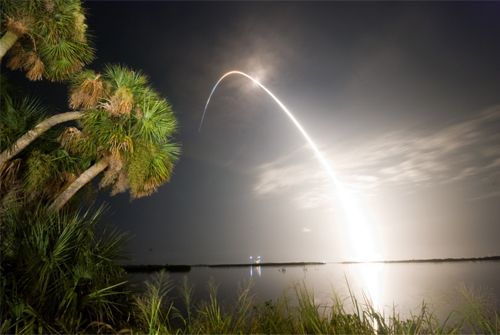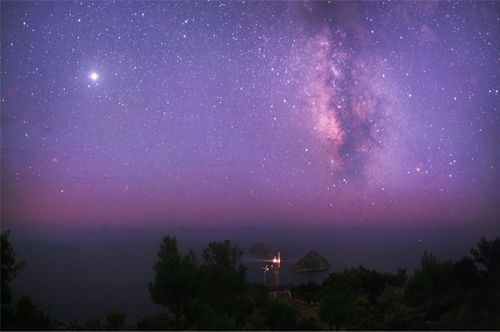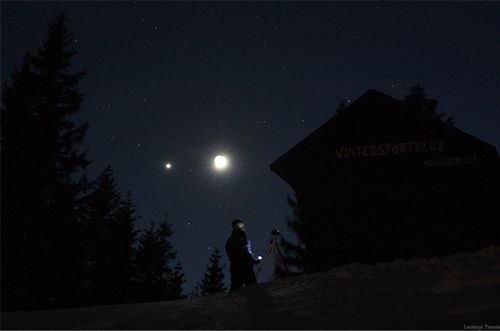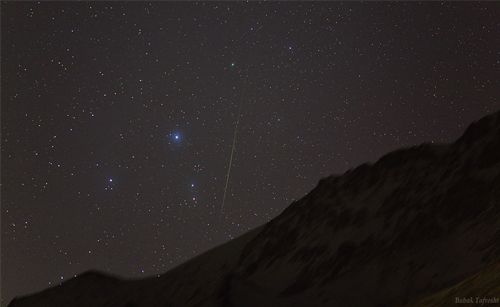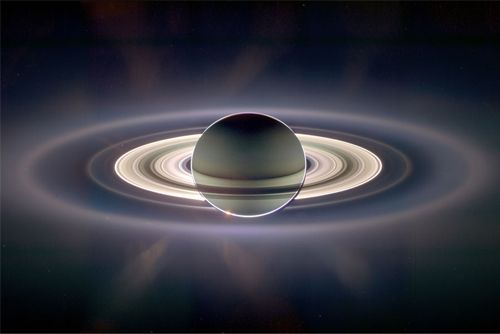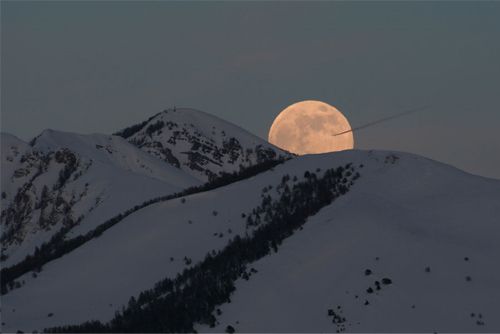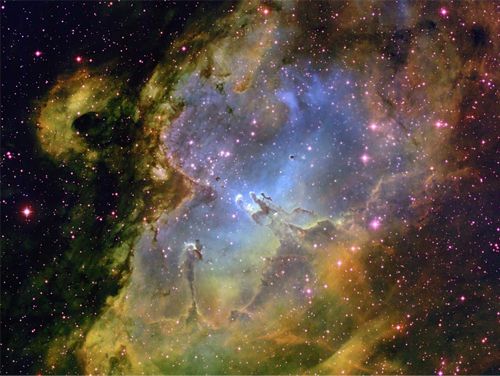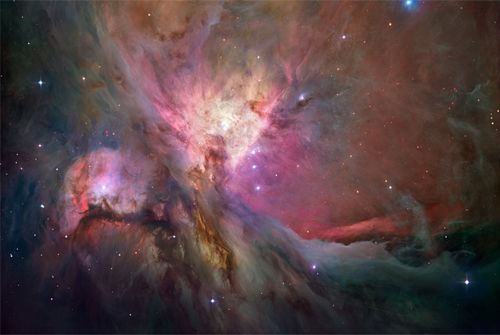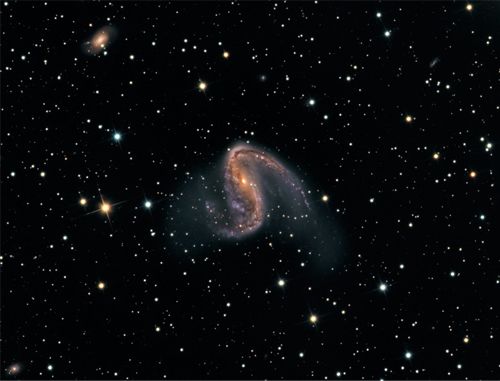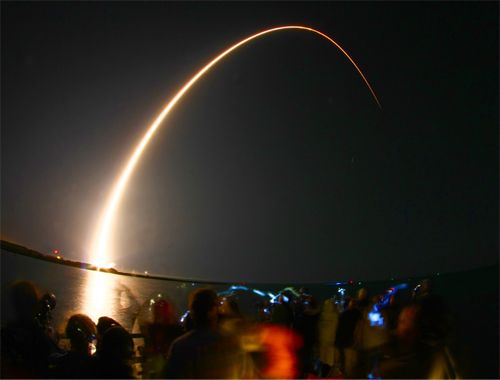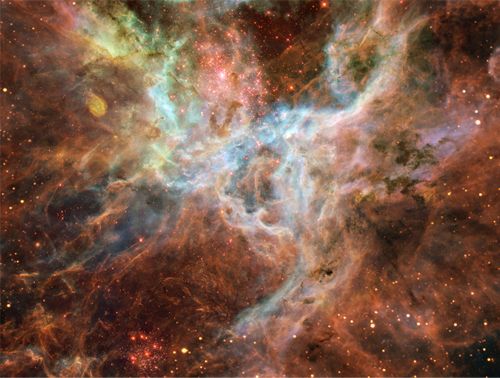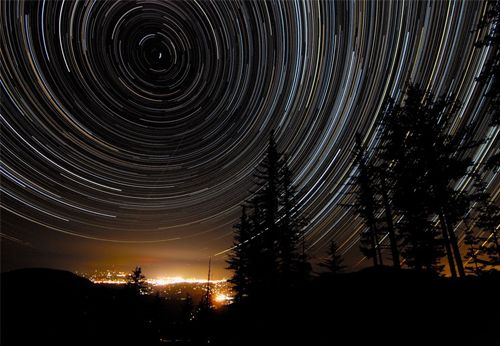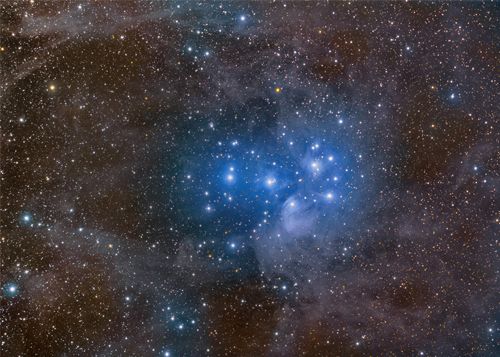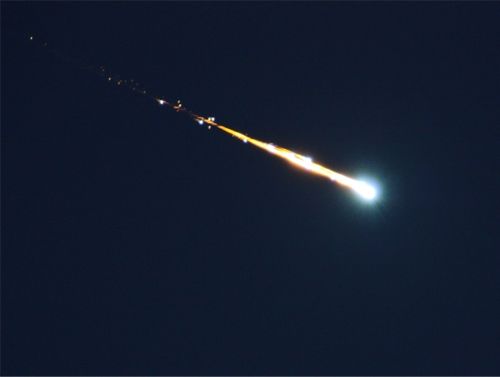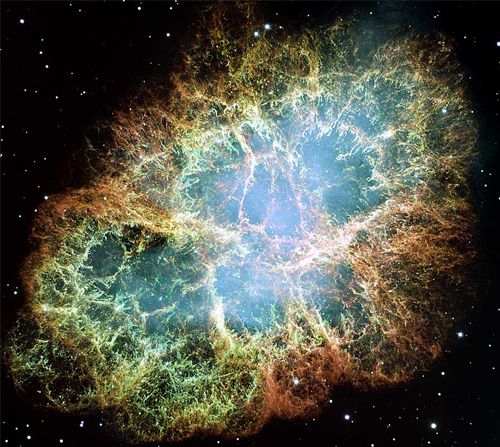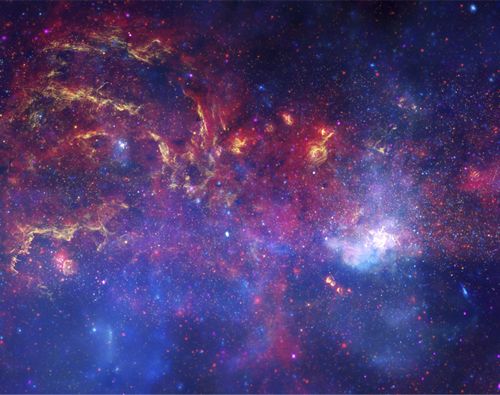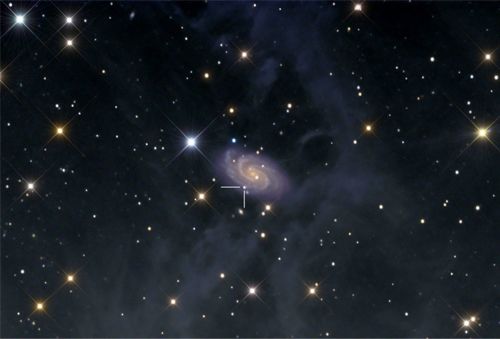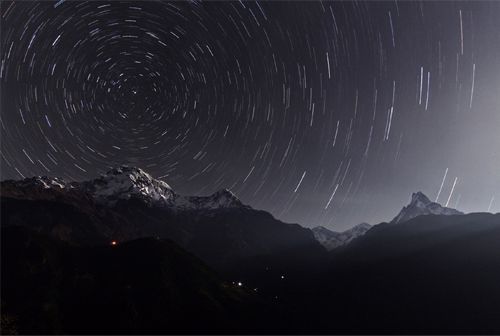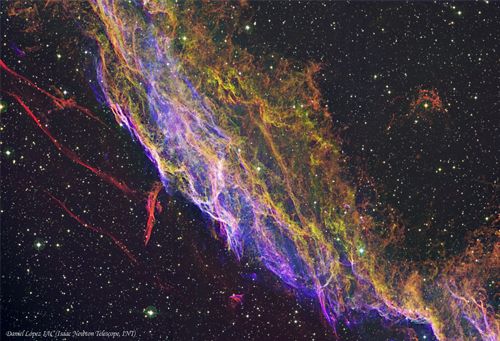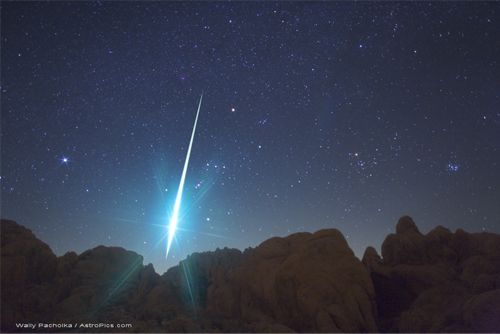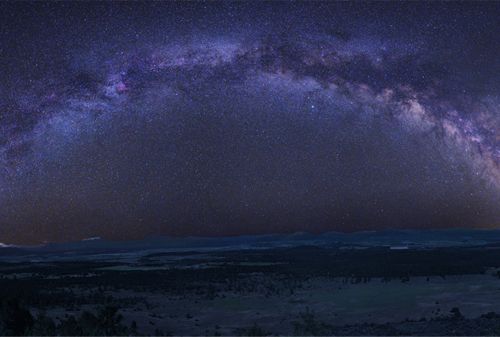Alpine Conjunction
The last conjunction of Moon and bright planets in 2008 featured a young crescent Moon and brilliant Venus in the west after sunset on December 31st. Seen here in dark, clear, mountain air from Mönichkirchen, Austria, are the two celestial beacons that dominate planet Earth’s night sky.
Comet and Meteor
This meteor streaking toward the horizon through the early morning sky of January 4th is from the annual Quadrantid meteor shower. Aligned with the shower’s radiant point high in the north (off the top of the view), the meteor trail passes to the right of bright bluish star Beta Scorpii.
In the Shadow of Saturn
The robotic Cassini spacecraft now orbiting Saturn recently drifted in giant planet’s shadow for about 12 hours and looked back toward the eclipsed Sun. Cassini saw a view unlike any other. First, the night side of Saturn is seen to be partly lit by light reflected from its own majestic ring system. Next, the rings themselves appear dark when silhouetted against Saturn, but quite bright when viewed away from Saturn, slightly scattering sunlight, in this exaggerated color image.
Largest Full Moon of 2009
A larger moon will not be seen this year. In the first week of January the largest full Moon of 2009 was seen from almost any clear location on planet Earth at night. The large angular extent of the full Moon was caused by the Moon being unusually close to Earth during its full phase.
A Partial Eclipse Over Manila Bay
On 26th Jan, the Moon eclipsed part of the Sun as visible from parts of Africa, Australia, and Asia. In particular the above image, taken from the Mall of Asia seawall, caught a partially eclipsed Sun setting over Manila Bay in the Philippines. Piers are visible in silhouette in the foreground.
Inside the Eagle Nebula
A closer look at the Eagle Nebula, however, shows the bright region is actually a window into the center of a larger dark shell of dust. Through this window, a brightly-lit workshop appears where a whole open cluster of stars is being formed. In this cavity tall pillars and round globules of dark dust and cold molecular gas remain where stars are still forming.
Snake in the Dark
Dark nebulae snake across a gorgeous expanse of stars in this telescopic view toward the pronounceable constellation Ophiuchus and the center of our Milky Way Galaxy. In fact, the twisting central shape seen here is well known as the Snake Nebula. It is also listed as Barnard 72 (B72), one of 182 dark markings of the sky cataloged in the early 20th century by astronomer E. E. Barnard.
Orion Nebula: The Hubble View
Also known as M42, the nebula’s glowing gas surrounds hot young stars at the edge of an immense interstellar molecular cloud only 1,500 light-years away. The Orion Nebula offers one of the best opportunities to study how stars are born partly because it is the nearest large star-forming region, but also because the nebula’s energetic stars have blown awayobscuring gas and dust clouds that would otherwise block our view – providing an intimate look at a range of ongoing stages of star birth and evolution.
NGC 2442: Galaxy in Volans
Distorted galaxy NGC 2442 can be found in the southern constellation of the flying fish, (Piscis) Volans. Located about 50 million light-years away, the galaxy’s two spiral arms extending from a pronounced central bar give it a hook-shaped appearance. This deep color image also shows the arms’ obscuring dust lanes, young blue star clusters and reddish star forming regions surrounding a core of yellowish light from an older population of stars.
Kepler’s Streak
Streaking skyward, a Delta II rocket carries NASA’s Kepler spacecraft aloft into the clear night of March 6. The dramatic scene was recorded in a time exposure from the crowded pier in Jetty Park at the northern end of Cocoa Beach, Florida, about 3 miles from the Cape Canaveral launch site. Kepler’s mission is to search for Earth-like planets orbiting in the habitable zone of other stars.
Tycho’s Supernova Remnant
Pictured above is the best multi-wavelength image yet of Tycho’s supernova remnant, the result of a stellar explosion first recorded over 400 years ago by the famous astronomer Tycho Brahe. The above image is a composite of an X-ray image taken by the orbiting Chandra X-ray Observatory, an infrared image taken by the orbiting Spitzer SpaceTelescope, and an optical image taken by the 3.5-meter Calar Alto telescope located in southern Spain.
The Seahorse of the Large Magellanic Cloud
It may look like a grazing seahorse, but the dark object toward the image right is actually a pillar of smoky dust about 20 light years long. The curiously-shaped dust structure occurs in our neighboring Large Magellanic Cloud, in a star forming region very near the expansive Tarantula Nebula. The energetic nebula is creating a star cluster, NGC 2074, whose center is visible just off the top of the image in the direction of the neck of the seahorse.
In the Heart of the Tarantula Nebula
In the heart of monstrous Tarantula Nebula lies huge bubbles of energetic gas, long filaments of dark dust, and unusually massive stars. In the center of this heart, is a knot of stars so dense that it was once thought to be a single star. This star cluster, labeled as R136 or NGC 2070, is visible just above the center of the above image and home to a great number of hot young stars.
Star Trails Over Oregon
As the Earth spins on its axis, the sky seems to rotate around us. This motion, called diurnal motion, produces the beautiful concentric trails traced by stars during time exposures. Partial-circle star trails are pictured above over Grants Pass, Oregon, USA in August. Near the middle of the circles is the North Celestial Pole (NCP), easily identified as the point in the sky at the center of all the star trail arcs.
Ultraviolet Andromeda
Taken by a telescope onboard NASA’s Swift satellite, this stunning vista represents the highest resolution image ever made of the Andromeda Galaxy (aka M31) – at ultraviolet wavelengths. The mosaic is composed of 330 individual images covering a region 200,000 light-years wide. It shows about 20,000 sources, dominated by hot, young stars and dense star clusters that radiate strongly in energetic ultraviolet light.
Carina Pillar and Jets
This cosmic pillar of gas and dust is nearly 2 light-years wide. The structure lies within one of our galaxy’s largest star forming regions, the Carina Nebula, shining in southernskies at a distance of about 7,500 light-years. The pillar’s convoluted outlines are shaped by the winds and radiation of Carina’s young, hot, massive stars. But the interior of the cosmic pillar itself is home to stars in the process of formation.
Pleiades and Stardust
Perhaps the most famous star cluster on the sky, the Pleiades can be seen withoutbinoculars from even the depths of a light-polluted city. Also known as the Seven Sisters and M45, the Pleiades is one of the brightest and closest open clusters. Hurtling through a cosmic dust cloud a mere 400 light-years away, the Pleiades or Seven Sisters star cluster is well-known for its striking blue reflection nebulae.
Fireball Meteor Over Groningen
The brilliant fireball meteor captured in this snapshot was a startling visitor of 13th October’s evening twilight skies over the city of Groningen. In fact, sightings of the meteor, as bright as the Full Moon, were widely reported throughout the Netherlands and Germany at approximately 17:00 UT.
M1: The Crab Nebula from Hubble
This is the mess that is left when a star explodes. The above image, taken by the Hubble Space Telescope, is presented in three colors chosen for scientific interest. The Crab Nebula spans about 10 light-years. In the nebula’s very center lies a pulsar: a neutron star as massive as the Sun but with only the size of a small town. The Crab Pulsar rotates about 30 times each second.
Blue Sun Bristling
The above picture of our Sun was taken in October in a specific red color of light emitted by hydrogen gas called Hydrogen-alpha and then color inverted to appear blue. In this light, details of the Sun’s chromosphere are particularly visible, highlighting numerous thin tubes of magnetically-confined hot gas known as spicules rising from the Sun like bristles from a shag carpet. Fire is the rapid acquisition of oxygen, and there is very little oxygen on the Sun. The energy source of our Sun is the nuclear fusion of hydrogen into helium deep within its core.
Halloween’s Moon
Illuminating the landscape all through the night of November 2nd, the week’s bright Full Moon was known in the northern hemisphere as a Hunter’s Moon. But this dramatic view of the shining lunar orb, from Sobreda, Portugal, was captured just a few nights earlier, on Halloween.
Great Observatories Explore Galactic Center
In celebration of Galileo’s telescopic achievements and as part of the International Year of Astronomy, NASA used its entire fleet of Great Observatories, and the Internet, to bring the center of our Galaxy to you. Pictured above, in greater detail and in more colors than ever seen before, are the combined images of the Hubble Space Telescope in near-infrared light, the Spitzer Space Telescope in infrared light, and the Chandra X-rayObservatory in X-ray light. A menagerie of vast star fields is visible, along with dense star clusters, long filaments of gas and dust, expanding supernova remnants, and the energetic surroundings of what likely is our Galaxy’s central black hole.
Art and Science in NGC 918
The island universe is about 50,000 light-years across and lies some 60 million light-years away toward the constellation Aries. An artistic presentation, the image shows spiky foreground stars in our own Milky Way Galaxy and convoluted dust clouds that hang hundreds of light-years above our galactic plane, dimly reflecting starlight. It also captures NGC 918 in a cosmic moment important to astrophysicists on planet Earth.
Annapurna Star Trails
From left to right the three main peaks are Annapurna South (7,219 meters), Hiunchuli (6,441 metes), and Machapuchare (6,995 meters). Of course the mountains are moving not the stars, the Earth’s rotation about its axis causing the concentric star trails recorded in the time exposure. Positioned above Annapurna South, the North Celestial Pole is easily identified as the point at the center of all the star trail arcs. The star Polaris, also known as the North Star, made the very short and bright arc closest to the North Celestial Pole.
NGC 6992: Filaments of the Veil Nebula
About 7,500 years ago that star exploded in a supernova leaving the Veil Nebula, also known as the Cygnus Loop. At the time, the expanding cloud was likely as bright as a crescent Moon, remaining visible for weeks to people living at the dawn of recorded history. Now, the resulting supernova remnant has faded and is now visible only through a small telescope directed toward the constellation of the Swan (Cygnus). The remaining Veil Nebula is physically huge, however, and even though it lies about 1,400 light-years distant, it covers over five times the size of the full Moon. In images of the complete Veil Nebula, studious readers should be able to identify the above filaments on the lower left. The above image is a mosaic from the 2.5-meter Isaac Newton Telescope at Roque de los Muchachos Observatory in the Canary Islands.
Mojave Desert Fireball
Monstrously bright, this fireball meteor lit up the Mojave Desert sky on Dec 14th morning, part of this year’s impressive Geminid meteor shower. Seen toward the southwest over rock formations near Victorville, California, a more familiar celestial background was momentarily washed out by the meteor’s flash. The background includes bright star Sirius at the left, and Aldebaran and the Pleaides star cluster at the right side of the image.
Aurora Shimmer, Meteor Flash
Northern Lights, or aurora borealis, haunted skies over the island of Kvaløya, near Tromsø Norway on December 13. This 30 second long exposure records their shimmering glow gently lighting the wintery coastal scene. A study in contrasts, it also captures the sudden flash of a fireball meteor from December’s excellent Geminid meteor shower. Streaking past familiar stars in the handle of the Big Dipper, the trail points back toward the constellation Gemini, off the top of the view.
A Graceful Arc
The graceful arc of the Milky Way begins and ends at two mountain peaks in this solemn night sky panorama. Created from a 24 frame mosaic, exposures tracking Earth and sky were made separately, with northern California’s Mount Lassen at the left and Mount Shasta at the far right, just below the star and dust clouds of the galactic center.








































